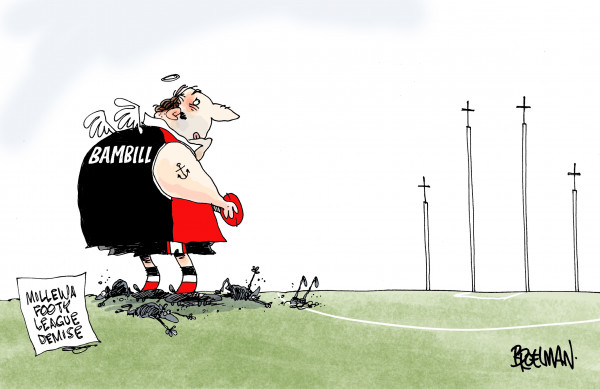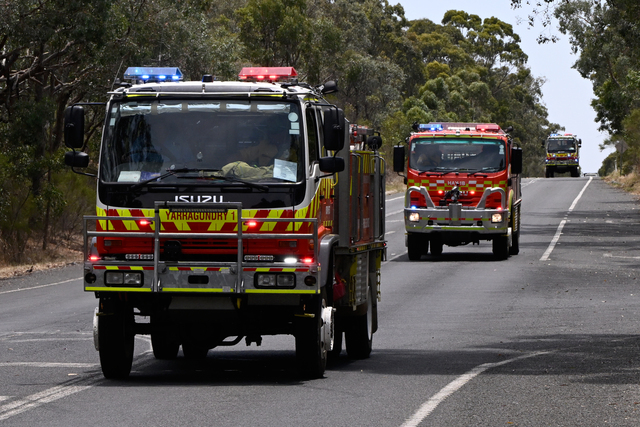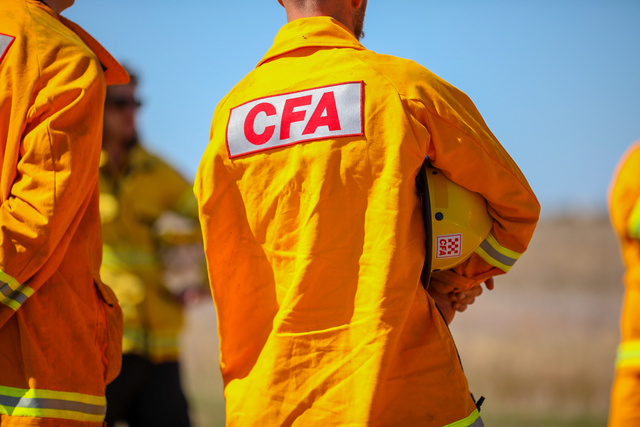BAMBILL 55.28 (358) d Meringur 0.
Take a moment to reflect on this result from the Millewa Football League last Saturday, which took top-placed Bambill’s percentage to a mammoth 677.94.
Brad Congress kicked 24 goals, taking his season’s tally to a Victorian country-league high 87 majors in nine games for Bambill, whose average winning margin is 174 points.
Congress reportedly felt “a little bit embarrassed” by kicking that many goals in a game where the class divide was as wide as Sydney Harbour.
This is not about having a crack at Bambill, nor is it at Meringur, who are fighting hard for survival during the post-COVID player drain in country football.
I congratulate Bambill for being pro-active, moving into town at Mildura Senior College and recruiting some quality players like Luke Stanbrook and Congress.
But there’s something seriously wrong with the competition when you have Bambill racking up winning margins since round 3 of 197, 260, 209, 201, 139, 150 and last week’s 358.
Conversely, the losing margins for Meringur’s men’s team in the opening nine rounds of the season have been 255, 224, 215, 260, 181, 201, 126, 189 and last week’s 358.
A glance at the Sunraysia Women’s Football League scores last weekend showed more heavily lopsided results.
Meringur were beaten 137-0 by Bambill, and Werrimull flogged Cardross 138-0.
North-west Victoria is not the only country football area that is struggling.
The Tallangatta & District League, in north-east Victoria, has seen clubs like Wahgunyah cop regular hammerings this season.
Its worst loss was 431-1 in early May.
The 97-year-old, six-team Millewa Football League has a long and proud history.
But how is it sustainable in its current form?
I spoke with the Millewa league’s president, John Hall, as well as Sunraysia Football and Netball League president Paul Matheson this week to see how they plan to make football more sustainable in the region.
Hall called for a round-table meeting at season’s end between the AFL Sunraysia Commission, SFNL and Millewa representatives to work on a long-term fix.
It comes after AFL Sunraysia Commission president Ross Lanyon said earlier this year that there was a “need for regular meetings between all Sunraysia football bodies”.
For Hall, a life member of the league, it’s a distressing time. However, he is frank when asked about where the competition will go from here.
“Meringur is confident they’ll survive till the end of the season,” he said.
“If we get through this year, then we’ll have to look at next year and beyond.
“It’s very lopsided and that can’t continue. The whole concept of Sunraysia and Millewa football has got to be looked at. It can’t survive the way it is now.”
He pinned the decline in standards on the drop-off in players.
“It’s not a matter of clubs not trying. Meringur are trying their bloody heart out, and so is Werrimull and so is everybody else,” Hall said.
“But there’s just not the players anymore.”
I asked both Hall and Matheson about how serious the Millewa competition should be seen.
“The reality is that it’s a social competition. That’s the way it’s looking for me,” Matheson said.
But Hall hit back: “It’s not a social competition. People got this idea a number of years ago that players would finish in the SFL and come out to the Millewa for a bit of fun.
“Well, that hasn’t been the case for years. We’ve had some bloody good footballers in our league.
“I was involved with Gol Gol for years and we were fair dinkum about winning flags. It was never a Mickey Mouse competition.”
For Matheson, the key question about the Millewa league’s future is, “what’s a sustainable number of clubs for the league to continue?”
“Are the other clubs willing to play if Meringur wasn’t involved in the competition?” he said.
“The whole thing will be driven by the Millewa, in terms of whether they think it’s sustainable or not.”
Could there be any room for Millewa clubs in the SFNL?
“There’s been talk of having two divisions … where if you win division two, you’d get promoted into division one,” Matheson said.
“But we’re driven by our (nine) member clubs, and they are keen to play as one entity.
“If you start to bring in different teams that don’t have juniors, it creates issues with the draw.”
How about mergers between SFNL and Millewa clubs, such as Imperials with Gol Gol, or Meringur and Merbein?
“That’s been talked about for 30 years,” Hall said.
“I’m not a fan of this, because I think it will be the end of the Millewa anyway. The SFNL club in any merger would just take over.”
It’s clear there is no easy fix to the Millewa’s woes.
No one wants to see clubs or leagues die. But some hard decisions will need to made soon because for the Millewa, it’ll be death by a thousand cuts (or clobberings).







